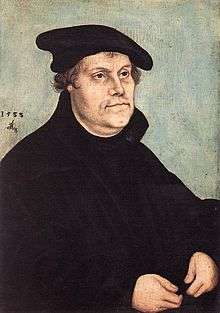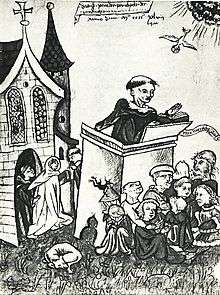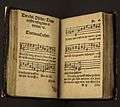Nun bitten wir den Heiligen Geist
| "Nun bitten wir den Heiligen Geist" | |
|---|---|
| Hymn by Martin Luther | |
 Lucas Cranach: Luther in 1543 | |
| English | We now implore the Holy Ghost |
| Text | by Martin Luther |
| Language | German |
| Based on | chant |
| Published | 1524 |
"Nun bitten wir den Heiligen Geist" (We now implore the Holy Ghost) is a hymn in four stanzas. The first stanza dates from the 13th century and alludes to the Latin sequence Veni Sancte Spiritus, three other stanzas were written by Martin Luther. The Holy Spirit is addressed, but the general theme makes the hymn appropriate not only for Pentecost, but also for general occasions and funerals. The chorale is part of many hymnals, sung in several Christian denominations and in translations. The text inspired vocal and organ music from the Renaissance to contemporary, including composers such as Michael Praetorius, Dieterich Buxtehude and Johann Sebastian Bach, among others.
History and text

The first stanza is found in the 13th century: the Franciscan Berthold von Regensburg (died 1272) quoted it in a sermon.[1][2][3]
- Nû biten wir den heiligen geist
- umbe den rechten glouben allermeist,
- daz er uns behüete an unsrem ende,
- sô wir heim suln varn ûz disem ellende.
- Kyrieleis.[1]
It is a prayer in German to the Holy Spirit, reminiscent of the Latin sequence Veni Sancte Spiritus.[4] The concern is "most of all" (allermeist) the "right faith" (rechten glouben), considering to return "home" (heim) after the "exile" (ellende) of life. In the old German, "ellende" meant exile and was stressed on the second syllable, rhyming with "ende", whereas the modern "Elend" is stressed on the first syllable and translates to "misery".[5]
Luther continued by addressing the Holy Spirit in prayer in further stanzas as "Du wertes Licht" (You esteemed light), "Du süße Lieb" (You sweet love) and "Du höchster Tröster" (You highest comforter).[6] The hymn is a "Leise", concluding each stanza by "Kyrieleis".[4] The three added stanzas can be seen related to Paul's concept of "Glaube, Liebe, Hoffnung" (faith, love, hope), as expressed in his First Epistle to the Corinthians, 1 Corinthians 13:13.[7] Luther's text appeared first in 1524 in Wittenberg in Eyn geystlich Gesangk Buchleyn.[6]
In Lutheran liturgies it has been the main hymn (Hauptlied) for Pentecost. The chorale is part of many hymnals, sung in several Christian denominations and in translations. The oldest translation to Danish appeared in 1528.[1] Translations to English include "We now implore God the Holy Ghost" in "The Lutheran Hymnal", St. Louis, 1941.[8] In the Catholic hymnal in Germany, the first stanza and the tune is the same, but the text is continued differently by two poets, three stanzas by Maria Luise Thurmair (1912–2005) and a concluding stanza by Michael Vehe (1537).[7]
Melody and musical settings
The tune was derived from the chant of the sequence and appeared first in Jistebnitz around 1420.[4][6] Luther's version appeared in 1524 in Wittenberg in Geystliche gesangk Buchleyn, set for four parts by Johann Walter, who collaborated with Luther.[6] Michael Praetorius composed seven a cappella settings, for two to six voices.[9] Dieterich Buxtehude composed two organ preludes, BuxWV 208 and BuxWV 209. Johann Sebastian Bach used the third stanza in his cantata Gott soll allein mein Herze haben, BWV 169, composed in Leipzig for the 18th Sunday after Trinity on 20 October 1726.
Organ preludes were composed by Georg Böhm, Helmut Eder, Paul Hamburger, Arnold Mendelssohn, Ernst Pepping, Heinrich Scheidemann, Heinrich Scheidemann, Johann Gottfried Vierling, Helmut Walcha and Johann Gottfried Walther, among others.[10]
Johann Nepomuk David wrote in 1936 a Choralmottete (chorale motet) for four-part choir a cappella Nun bitten wir den heiligen Geist.[11] It is the first movement of Ernst Pepping's Deutsche Choralmesse (Chorale Mass in German) for six voices a cappella (SSATBB).[12]
Herbert Blendinger composed in 1984 for cello and organ Meditation über den Choral „Nun bitten wir den heiligen Geist“ Op. 36.[13] Jacques Wildberger composed Diaphanie: per viola sola: fantasia su per "Veni creator spiritus" et canones diversi super "Nun bitten wir den heiligen Geist", published in Zürich in 1989.[14]
See also
References
- 1 2 3 "Evangelical Lutheran Hymnary Handbook / Hymn Texts and Tunes / We now implore God the Holy Ghost # 33". blc.edu. 2011. Retrieved 24 October 2011.
- ↑ Berthold von Regensburg, vollständige Ausgabe seiner Predigten, Bd. 1: mit Anmerkungen und Wörterbuch von Franz Pfeiffer (in German). 1862. p. 43. Retrieved 16 December 2011.
- ↑ "Michael Praetorius / Nun bitten wir den Heiligen Geist" (in German). Carus-Verlag. 2011. Retrieved 24 October 2011.
- 1 2 3 "Chorale Melodies used in Bach's Vocal Works / Christ ist erstanden". bach-cantatas.com. 2011. Retrieved 24 October 2011.
- ↑ Friedrich Kluge (1975). Etymologisches Wörterbuch (in German) (21 ed.). p. 163.
- 1 2 3 4 "Luthers Lieder / Nun bitten wir den Heiligen Geist" (in German). luther-gesellschaft.com. 2011. Retrieved 24 October 2011.
- 1 2 Michael Fischer (2007). "Populäre und traditionelle Lieder. Historisch-kritisches Liederlexikon / Nun bitten wir den heiligen Geist" (in German). liederlexikon.de. Retrieved 24 October 2011.
- ↑ "We now implore God the Holy Ghost". hymnary.org. 2011. Retrieved 24 October 2011.
- ↑ George J. Buelow (2004). A history of baroque music. Indiana University Press. p. 208. Retrieved 24 October 2011.
- ↑ "Chorale Preludes on the tune "Nun bitten wir den"". organ-biography.info. 2011. Retrieved 10 November 2011.
- ↑ "Werke für Chor". johann-nepomuk-david.org. 2011. Retrieved 10 November 2011.
- ↑ "Deutsche Choralmesse". Schott. 2011. Retrieved 10 November 2011.
- ↑ "Instrumentalwerke" (in German). Herbert Blendinger. 2011. Retrieved 10 November 2011.
- ↑ "Viola-Solo". music.lib.byu.edu. 2011. Retrieved 10 November 2011.
External links
- We now implore God the Holy Ghost cyberhymnal.org
- XIX.: Nun bitten wir den heiligen Geist. Now pray we all God, the Comforter. - Martin Luther, The Hymns of Martin Luther (1884) Online Library of Liberty
- We Now Implore God the Holy Ghost (also known as To God the Holy Spirit Let Us Pray or O Holy Ghost to Thee We Pray or Now Do We Pray God the Holy Ghost or Now Pray We All God the Comforter or Now Let Us Pray to the Holy Ghost) openhymnal.org
- Texts › Nun bitten wir den heiligen Geist › Instances hymnary.org
